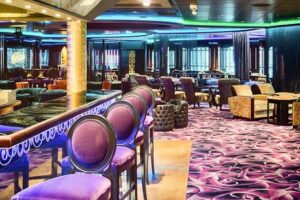From the lighting to the decor, every detail plays a role in shaping how customers perceive the establishment. However, one often overlooked aspect of restaurant design is the furniture. The seating in a restaurant can have a significant impact on customer experience, and understanding the psychology behind it can help restaurant owners create a more welcoming and memorable atmosphere.
Research has shown that customers are more likely to rate their dining experience positively when they feel comfortable and relaxed in their seating. The type of seating, its placement, and even the color can all contribute to how customers perceive the restaurant. Therefore, restaurant owners should pay close attention to their furniture choices and how they align with their overall brand and customer experience goals. In this article, we will explore the psychology of restaurant furniture and how seating impacts the customer experience.
The Role of Seating in Customer Perception
When you sit in a comfortable and well-designed chair, you’ll feel more relaxed and positive about your dining experience. This is because the seating in a restaurant plays a significant role in customer perception. The comfort level of the chairs and the overall design of the seating arrangement can determine how much a customer enjoys their meal and how likely they are to return to the restaurant in the future.
A restaurant’s seating can also influence how much time a customer spends in the establishment. Comfortable seating can encourage customers to linger and enjoy their meals, while uncomfortable seating can cause them to rush through their meals and leave quickly. In addition, the placement of tables and chairs can impact the social dynamic of the dining experience, as well as the level of privacy that customers feel. All of these factors can significantly impact the overall customer experience and ultimately determine the success of a restaurant.
Understanding Customer Behavior in Restaurants
You’ll notice that your behavior changes when you step into a restaurant – from the way you interact with the staff to the way you approach the menu. This is because restaurants are designed to elicit certain behaviors from customers. Understanding customer behavior in restaurants is essential, as it can help restaurateurs create spaces that enhance the dining experience.
One key aspect of customer behavior in restaurants is the way people respond to their surroundings. The design of a restaurant can influence the way people behave, with certain elements such as lighting, music, and seating impacting the customer experience. For example, research has shown that comfortable seating encourages customers to stay longer, while uncomfortable seating can lead to shorter dining times and lower levels of customer satisfaction. By understanding these behavioral cues, restaurant owners and designers can create spaces that are not only visually appealing but also conducive to a positive dining experience.
Types of Restaurant Seating and Their Effects
Different types of seating arrangements in a dining establishment can greatly influence how diners perceive their meal and their environment. For example, tables that are placed too close together can make customers feel cramped and uncomfortable, while spacious booths with high backs can provide a sense of privacy and intimacy. Additionally, the height and size of chairs can impact the overall dining experience. Chairs that are too low or too high can cause discomfort or unease, while chairs that are too small or too large can make customers feel like they don’t fit in.
Another factor to consider is the material and style of the seating. Hard, uncomfortable chairs can make customers feel like they’re being rushed out, while plush chairs and sofas can encourage them to linger and relax. The overall style of the seating can also set the tone for the dining experience. Sleek, modern chairs can create a trendy and upscale atmosphere, while rustic, wooden chairs can give off a cozy, homey vibe. By taking into account the various effects of different seating types, restaurant owners can create an environment that enhances the overall dining experience for their customers.
The Importance of Comfort and Functionality
Comfort and functionality are key factors for creating the perfect dining experience, where customers can relax and enjoy their meals. Restaurant furniture needs to be comfortable enough to allow customers to sit for extended periods without feeling fatigued or uncomfortable. The seats should also be easy to adjust to accommodate customers of different sizes and preferences. Additionally, the design of the seating should be functional, allowing wait staff to move around the tables seamlessly, while also providing enough space for customers to move in and out of their seats with ease.
When customers feel comfortable and relaxed, they are more likely to enjoy their meals and stay longer in the restaurant. Comfortable seating also helps customers to focus on the food and the dining experience, rather than on their discomfort. In addition, functional seating ensures that customers and wait staff can move around the restaurant without causing disruptions or delays. Thus, investing in comfortable and functional restaurant seating can help to create a positive dining experience for customers, which can lead to repeat business and positive reviews.
Creating a Welcoming and Memorable Dining Experience
Creating a warm and inviting atmosphere through lighting, decor, and music can leave a lasting impression on diners, making their dining experience truly memorable. However, it is important not to overlook the impact that restaurant furniture can have on the overall customer experience. The right seating can enhance the atmosphere, create comfort, and even influence diners’ behavior.
When choosing furniture, it is important to consider the style and theme of the restaurant. The furniture should complement the overall decor and contribute to the desired atmosphere. Additionally, comfort should always be a top priority. Uncomfortable seating can lead to a negative dining experience and discourage customers from returning. By investing in comfortable and visually appealing furniture, restaurants can create a welcoming and memorable dining experience for their customers.
In conclusion, the psychology of restaurant furniture is a crucial aspect of customer experience. The seating arrangement plays a significant role in how customers perceive the restaurant and their dining experience. Understanding customer behavior in restaurants is essential in selecting the right seating type and design. The comfort and functionality of the seating can impact the customer’s perception of the restaurant’s quality and service. Creating a welcoming and memorable dining experience is the ultimate goal, and the furniture and seating play a vital role in achieving that goal.
Therefore, restaurant owners must pay attention to the psychology of restaurant furniture and seating and invest in high-quality, comfortable, and functional seating that aligns with their brand and target customers. By doing so, they can enhance the customer’s dining experience, create a positive perception of their restaurant, and increase customer retention and revenue. In short, the psychology of restaurant furniture is not just about aesthetics but also about creating a comfortable and welcoming environment that enhances the customer’s experience and perception of the restaurant.
@media (max-width: 1200px) {
.ns-buttons.ns-inline .ns-button-icon { width: 100%; } .ns-buttons.ns-inline .ns-button-label { display: none; }
}.ns-inline:not(.ns-columns) .ns-buttons-wrapper {
justify-content: center;
}body .ns-inline:not(.ns-columns) a.ns-button, body .ns-inline .ns-total-share-count {
margin: 0px 5px 10px 5px;
}
Read more: The Psychology Of Restaurant Furniture: How Seating Impacts Customer Experience
Copyright: eTurboNews is Travel Industry News – Travel & Tourism Story Telling Exposed





